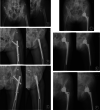Surgical Treatment of Internal Fixation Failure of Femoral Peritrochanteric Fracture
- PMID: 34142451
- PMCID: PMC8523769
- DOI: 10.1111/os.13110
Surgical Treatment of Internal Fixation Failure of Femoral Peritrochanteric Fracture
Abstract
Objective: To investigate the factors, surgical treatment methods and clinical effect of internal fixation failure of intertrochanteric and subtrochanteric fractures.
Methods: From June 2015 to May 2019, arthroplasty and internal fixation revision were used to treat 18 cases of internal fixation failure of intertrochanteric and subtrochanteric fractures. There were 10 males and eight females, with an average age of 67.3 years (38-92 years). The 16 cases of initial intertrochanteric fractures were classified according to AO/OTA:13 cases of A2 and 3 cases of A3, the other 2 cases were subtrochanteric fractures (Seinsheimer type IV). The internal fixation failure was treated with total hip arthroplasty (6 cases), bipolar hemiarthroplasty (4 cases), revision with proximal femoral lockingplate (4 cases) and extend intramedullary nail (4 cases).
Results: All patients were followed up for an average of 24.7 months (range, 12 to 36 months). The average operative time was 111.4 min (range, 72 to 146 min) and the average intraoperative blood loss was 403.6 mL (range, 200 to 650 mL). The average time of fracture union was 6.9 months (range, 5 to 9 months) for cases of internal fixation revision. The operative time of the arthroplasty group was shorter than the revision group (P < 0.001), and the intraoperative blood loss of the arthroplasty group was less than the revision group (P = 0.001). The affected limb shortening of postoperative (0.21 ± 0.19 cm) was better than preoperative (2.01 ± 0.60 cm) (P < 0.001), while the limb shortening of the arthroplasty group (0.11 ± 0.21 cm) was less than the revision group (0.33 ± 0.09 cm) (P = 0.015). At the last follow-up, all injured limbs regained walking function, and the Harris hip score was 81.3 ± 9.4 points. The Harris score of postoperative was better than preoperative (33.4 ± 5.9 points) (P < 0.001), while there were no significant differences between the arthroplasty group and the revision group at 3 months (76.5 ± 8.5 vs 71.1 ± 10.6, P = 0.249), 6 months (80.9 ± 7.9 vs 78.9 ± 12.9,P = 0.687) postoperative and the last follow-up (80.5 ± 8.3 vs 82.3 ± 11.7, P = 0.716) respectively.
Conclusion: For internal fixation failure of peritrochanteric fractures, young patients could accept internal fixation revision to restore normal anatomical structure, correct varus deformity and autograft; while elderly patients and patients with damaged femoral head could be treated with arthroplasty to restore walking function.
Keywords: Arthroplasty; Failure; Intertrochanteric fracture; Revision; Subtrochanteric fracture.
© 2021 The Authors. Orthopaedic Surgery published by Chinese Orthopaedic Association and John Wiley & Sons Australia, Ltd.
Figures



Similar articles
-
Salvage of failed subtrochanteric fracture fixation in the elderly: revision internal fixation or hip arthroplasty?Eur J Orthop Surg Traumatol. 2024 Aug;34(6):3097-3101. doi: 10.1007/s00590-024-04035-0. Epub 2024 Aug 26. Eur J Orthop Surg Traumatol. 2024. PMID: 39186097
-
[Medium-term efficacy of bio-lengthened stem arthroplasty in the treatment of unstable intertrochanteric femoral fractures in elderly patients].Zhongguo Gu Shang. 2020 Apr 25;33(4):322-6. doi: 10.12200/j.issn.1003-0034.2020.04.007. Zhongguo Gu Shang. 2020. PMID: 32351085 Chinese.
-
[Treatment of peri-implant refracture after intramedullary nail fixation for intertrochanteric fractures].Zhongguo Xiu Fu Chong Jian Wai Ke Za Zhi. 2021 Mar 15;35(3):312-317. doi: 10.7507/1002-1892.202010011. Zhongguo Xiu Fu Chong Jian Wai Ke Za Zhi. 2021. PMID: 33719239 Free PMC article. Chinese.
-
[Trochanteric femoral fractures].Acta Chir Orthop Traumatol Cech. 2013;80(1):15-26. Acta Chir Orthop Traumatol Cech. 2013. PMID: 23452417 Review. Czech.
-
Classification and surgical approaches to hip fractures for nonsurgeons.Clin Geriatr Med. 2014 May;30(2):229-41. doi: 10.1016/j.cger.2014.01.004. Epub 2014 Mar 6. Clin Geriatr Med. 2014. PMID: 24721363 Review.
Cited by
-
Clinical observation and finite element analysis of femoral stable interlocking intramedullary nail in intertrochanteric fractures.Int Orthop. 2023 Sep;47(9):2319-2326. doi: 10.1007/s00264-023-05865-z. Epub 2023 Jun 26. Int Orthop. 2023. PMID: 37358574
-
Five states of reduction in OTA/AO A1.3 intertrochanteric fractures of the femur a biomechanical study.BMC Musculoskelet Disord. 2024 Oct 28;25(1):857. doi: 10.1186/s12891-024-07990-1. BMC Musculoskelet Disord. 2024. PMID: 39465375 Free PMC article.
-
Effects of surgical treatment modalities on postoperative cognitive function and delirium in elderly patients with extremely unstable hip fractures.World J Psychiatry. 2023 Aug 19;13(8):533-542. doi: 10.5498/wjp.v13.i8.533. eCollection 2023 Aug 19. World J Psychiatry. 2023. PMID: 37701542 Free PMC article.
-
Descriptive analysis of incidence and risk factors for short intramedullary nail breakage in femoral intertrochanteric fractures: a multicenter (TRON group) retrospective study.Eur J Orthop Surg Traumatol. 2024 Jul;34(5):2605-2611. doi: 10.1007/s00590-024-03957-z. Epub 2024 May 7. Eur J Orthop Surg Traumatol. 2024. PMID: 38713443
-
Reconstruction intramedullary nailing for a failed subtrochanteric Seinsheimer type IIB fracture: a case report.Front Surg. 2023 May 12;10:1172971. doi: 10.3389/fsurg.2023.1172971. eCollection 2023. Front Surg. 2023. PMID: 37251579 Free PMC article.
References
-
- Johnell O, Kanis JA. An estimate of the worldwide prevalence and disability associated with osteoporotic fractures. Osteoporos Int, 2006, 17: 1726–1733. - PubMed
-
- Giannoudis PV, Ahmad MA, Mineo GV, Tosounidis TI, Calori GM, Kanakaris NK. Subtrochanteric fracture nonunions with implant failure managed with the “diamond” concept. Injury, 2013, 44: S76–S81. - PubMed
-
- Ahrengart L, Törnkvist H, Fornander P, et al. A randomized study of the compression hip screw and gamma nail in 426 fractures. Clin Orthop Relat Res, 2002, 401: 209–222. - PubMed
-
- Utrilla AL, Reig JS, Muñoz FM, Tufanisco CB. Trochanteric gamma nail and compression hip screw for trochanteric fractures: a randomized, prospective, comparative study in 210 elderly patients with a new design of the gamma nail. J Orthop Trauma, 2005, 19: 229–233. - PubMed
Publication types
MeSH terms
LinkOut - more resources
Full Text Sources
Medical

